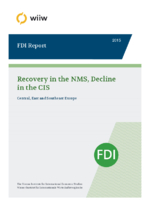Recovery in the NMS, Decline in the CIS
Gabor Hunya and Monika Schwarzhappel
wiiw FDI Report No. 2015-06, June 2015
141 pages including 103 Tables and 13 Figures
Content
- The first part of the publication contains an analysis of the latest FDI trends.
The analysis highlights the modest recovery of FDI in 2014. - The second part of the publication contains two sets of tables:
- Tables I: total flow and stock data, FDI flow by components and FDI income, FDI per capita and other FDI reference parameter (2006-2014)
- Tables II: detailed FDI data by economic activity and by country (last four years)
The main sources of data are the central banks of the individual Central, East and Southeast European countries.
General Description (PDF) | Table of contents (PDF)
Abstract
The first part of this report provides an analysis of the 2014 foreign direct investment (FDI) trends in 23 Central, East and Southeast European (CESEE) countries, highlighting uneven developments. FDI inflows recovered in the new EU Member States (NMS), stagnated in the Southeast European countries and plummeted in Russia and Ukraine.
Greenfield investments have declined in all three regions, but capital increases in foreign subsidiaries gathered momentum in the NMS. Even in this region, FDI inflow is still meagre in relation to gross fixed capital formation thus FDI is not a major driver of economic recovery.
The countries of the Commonwealth of Independent States (CIS), as well as Latvia and Lithuania, are receiving much less foreign investment than before, in the wake of the Ukraine crisis. Capital flight has hit Russia. Net FDI in the country has become negative as inflows declined by two thirds while outflows diminished only by one third. Chinese FDI contributes only a minor fraction to the FDI stock in the CESEE, but it is on the rise. More and larger greenfield projects originating in China and Hong Kong have been announced recently, first of all in Russia.
Forecasts for economic growth in 2015 suggest a further recovery of FDI in the NMS, although first-quarter trends in FDI flows and greenfield investments do not support this expectation.
The second part of this report contains two sets of tables: Tables I cover FDI flow and stock data, FDI flows by components and related income; Tables II provide detailed FDI data by economic activity and by country. The main sources of data are the central banks of the individual Central, East and Southeast European countries. Methodological explanations highlight important recent changes in reporting standards.
The wiiw FDI Database is available online
This online access with a modern query tool supports easy search and download of data.
The wiiw FDI Database contains the full set of FDI data with time series starting form 1990 as far as available.
Access to wiiw FDI Database
Reference to wiiw databases: wiiw Annual Database, wiiw FDI Database
Keywords: foreign direct investment, balance of payments, income repatriation, statistics, new EU Member States, Southeast Europe, CIS
JEL classification: C82, F21, O57, P23
Countries covered: Albania, Belarus, Bosnia and Herzegovina, Bulgaria, CIS, Croatia, Czechia, Estonia, Hungary, Kazakhstan, Kosovo, Latvia, Lithuania, North Macedonia, Moldova, Montenegro, New EU Member States, Poland, Romania, Russia, SEE, Serbia, Slovakia, Slovenia, Turkey, Ukraine
Research Areas: International Trade, Competitiveness and FDI
ISBN-13: 978-3-85209-044-3
